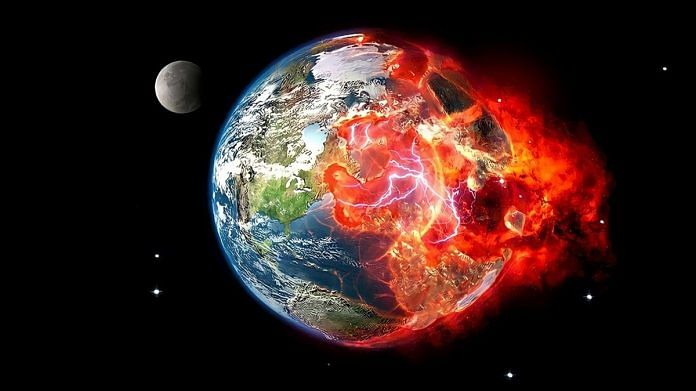Thank you dear subscribers, we are overwhelmed with your response.
Your Turn is a unique section from ThePrint featuring points of view from its subscribers. If you are a subscriber, have a point of view, please send it to us. If not, do subscribe here: https://theprint.in/subscribe/
The End of the World is a thought provoking commentary on the fate of the 21st century civilization as evident through multifaceted realities of geo-politics and international relations centered on economics. The book unravels a doomsday prospect of the future of the current century to a degree that should be unsettling for the people at the helm and civil society. It outlines many grave challenges awaiting millennials and Generation Z, warning that the current prosperity is the peak we could achieve before the breakdown of civilization begins. Some of these challenges discussed include, breakdown of supply chain systems, shortage of essential goods, devastating famines and more.
At the outset the book projects its thesis through the lens of history. The evolution of various economic systems in the past eventually led to the emergence of the free market system that generated a remarkable scale of wealth and prosperity. This international web of free market economy, also known as globalization, is powered by the synergy of the United States’ security guarantee of oceans and enormous consumer and manufacturing force around the world. Zeihan refers to the current prosperity under globalization as “the order”; an arch of security sustaining global stability and business.
According to Zeihan, the trajectory of the free market global economy is guaranteeing a collapse in the current century. He is driven to this conclusion purely based on demographic projections and various international geo-political trends.
Zeihan contends that many Global Powers, including China, are on the brink of catastrophic demographic collapse. He also rules out the continuation of US’s security guarantees of deep waters which is indispensable to smooth running of the current free market system. According to Zeihan, the ensuing scale of destruction from the great collapse will vary in effect from country to country. He posits that the US will be the most secure during the collapse and will be able to effectively repel its aftermath. While stating various reasons for it, he points out the US’s uniquely gifted geography as the most significant factor among all.
India in the De-globalized system
Peter recognizes India as a power to reckon with while also sharing his apprehensions about its economic potential.
In a dedicated column about India, Peter argues that the country’s solid federal structure and rich diversity, differentiates it from other major powers of the world. However, according to Peter, such scale heterogeneity in culture and power is antithetical to fostering great connections and smooth running of businesses.
With regards to the demographic projections, underpinning his “end of the world” theory, Zeihan recognizes India’s safe position compared to most countries. However, Peter dismisses the claim of India replacing China as the manufacturing hub, arguing that the former’s economic and political instability makes it a highly unlikely possibility. He argues that at minimum India can scale up its manufacturing capacity to serve its population of 1.4 billion.
On the other hand, Peter sees potential for the South East Asian countries particularly India in an FDI based model. In such a scenario, the withering workforce and consumption capacity in Japan will find its source in India, while India can benefit from Japan’s technological prowess, military might and capital. He asserts that such a model in South East Asia will be one of the “great alliances of the 21st century”.
On the energy front, Peter also believes that India’s naval security apparatus carries the wherewithal to help her secure important resources, especially oil. Pointing out India’s dominance in the Indian Ocean Peter remarks, “No East Asian power has the capacity to project naval force to the Persian Gulf without active Indian complicity.”
Peter shares serious concern regarding the looming water crisis in India. He argues that the collapse of the order will seriously impact the fruits of the green revolution which is sustained through globalization. Being the largest populated country, this will aggravate severe famine conditions for India.
In summary, India’s demographic dividend offers it a lifeline that guarantees its rise in the coming decades. India can utilize this period to scale up its manufacturing capacity. India’s naval power in the Indian Ocean will enable it to be energy secure amidst the collapse. However, its ossified federal and bureaucratic control are hindrances to its rise to glory as a superpower. The approaching water crisis will pose a serious threat to the country’s food security which is already the world’s most water poor country in per capita terms.
These pieces are being published as they have been received – they have not been edited/fact-checked by ThePrint.

